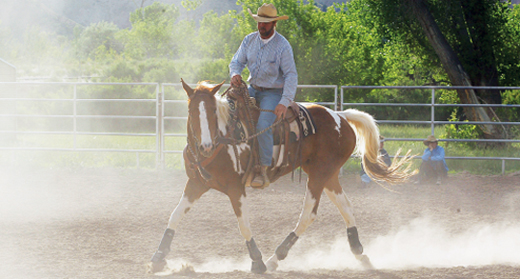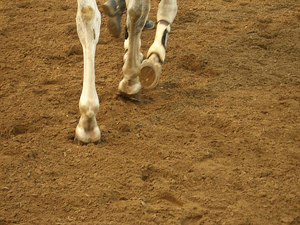If You Hate Breathing Arena Dust, Imagine How Your Horse Feels
A horse’s lungs are bigger than ours, so when we’re choking on the dust kicked up by equine footing, so is he, only more so. On average, a resting horse inhales 150 liters of air per minute. Add in strenuous exercise and your horse could realistically suck in 10 times that volume of arena dust. If your horse is older or has a history of respiratory infections or heaves, he could be even more susceptible to airway problems when breathing in airborne arena dust and dirt.
You know arena dust is bad. But maybe you also feel a little helpless to control the micro-climate that is your own personal arena dust storm. How exactly can you keep all that arena dust and dirt from rising? We’ve created an economical guide to help you control arena dust.
Before you can start to control dust, you need to understand what causes it.
There are four causes of arena dust:
1. Footing containing lightweight particles, such as unwashed sand that contains bits of clay, silt or broken-down organic (naturally occurring) materials. Imagine the particles of sand are the size of a basketball, In comparison, particles of clay are the size of a pinhead. So, the small bits float into the air, causing dust.
2. Sand pulverized by use. Over time, the weight and concussion of the horse’s hooves on the sand will break individual grains into smaller particles, which then become dust.
3. The arena base, usually made of clay or stone dust, begins to rise through the footing, becoming dust.
4. Manure, a fragile organic material left in the arena, gets broken down into small particles that easily go airborne. To protect you and your horse, keep a manure fork and muck bucket close by, and immediately scoop any poop left in the arena after your ride.
Based on what makes up dust, the basic way we control it is by adding weight to the small particles, which then keeps them from floating into the air.
Water helps but isn’t a perfect solution
Water is the most common way to add weight to footing and prevent arena dust, and it’s the method most of us fall back on. What horse show or clinic doesn’t stop midday for the water truck to make a pass around the arena? It isn’t, however, a perfect solution.
At home, a water truck most likely isn’t an option for your dust control efforts. Instead, you’ll probably rely on sprinklers or hand-watering with a spray nozzle. That means a lot of time and energy invested in this daily project. For indoor arenas, it might mean commercial installation of automatic sprinklers or drip systems, which can be expensive or unwise if the farm is on a well.
Using this natural resource in some areas is scarce and expensive when watering multiple times a day. It may be challenging, too, to get the soil/water recipe just right for riding. Adding too little water to your arena leads to a dust cloud after a couple laps, while the opposite of dust is mud. Over-watering can cause a slippery, mucky, potentially dangerous mess. In below-freezing temperatures it turns your arena to ice.
Imagine having an arena that has the perfect moisture content without having to do anything. That doesn’t require watering each time you go to ride. That saves you time and money. That doesn’t even freeze when temperatures get too low. Water retaining additives like Magnesium Chloride can do exactly that for your arena.
Water Retention
The next step is to use additives designed to retain moisture in the footing.
Magnesium Chloride is the preferred choice for arena dust control because of its strong hydroscopic properties. Hydroscopic means it attracts moisture. This moisture then binds to the dust particles when coated with magnesium chloride weighing them down and preventing them from going airborne. It’s an all natural product and certified organic by OMRI making it safe for you, your horse, and surrounding environment.
Magnesium chloride is recommended as it takes only 14 to 16 ounces per square foot to make a difference. The amount is considered minuscule, when compared to the 30 pounds of footing that make up each square foot of arena space. On uncovered arenas the rain washes the water soluble Magnesium Chloride away quicker so we recommend it for indoor or covered arenas only.
Final Notes
- Invest in a low-dust footing that won’t break down quickly under hoof.
- Be considerate of your neighbors and your horse, who may bare the brunt of your dust making.
- Pick manure out of your arena after each ride to prevent fine particles from turning into added dust.
- Use an additive that will retain moisture saving time, money, and your lungs.
Let us help you find the right application of Magnesium Chloride and you’ll have the perfect recipe for dust-free footing. Investing a little into your arena while working within your budget will make you and your horse be happier and healthier during and after your ride.
Watch a video to see how DustGard will help with your Horse Arena Dust Control.
Free Quotes for horse arena dust contol
Fill out a form or call 253-237-DUST (3878)




 Studies have shown that roads maintained with stabilization/dust control products save money by not having to grade and re-gravel as frequently. In addition, you get the added benefit of no dust!
Studies have shown that roads maintained with stabilization/dust control products save money by not having to grade and re-gravel as frequently. In addition, you get the added benefit of no dust!
 An affordable solution to all your dust control needs.
An affordable solution to all your dust control needs.
